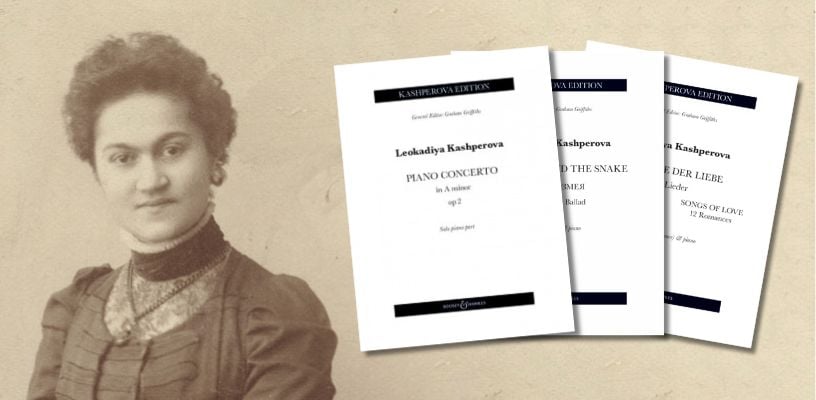Leokadiya Kashperova: Piano Concerto publication completes edition

The new Boosey & Hawkes edition of music by rediscovered Russian composer Leokadiya Kashperova is completed with the publication of her Piano Concerto, dating from 1900, together with a group of vocal scores.
Leokadiya Kashperova (1872-1940), hitherto consigned to a footnote in musical history as Stravinsky’s piano teacher, continues to undergo rediscovery. A double graduate of the St Petersburg Conservatoire, she emerged as a virtuoso pianist and composer in the Romantic tradition. She was associated with some of the great musicians of her day, including Balakirev and Auer. She performed in both Germany and the UK in the 1900s, but her career petered out after 1920, swept away by the tides of political change.
New releases in the Boosey & Hawkes Kashperova Edition include publications relating to one of her major scores, the Piano Concerto in A minor op.2. The virtuosic solo part is now available for pianists preparing the concerto for performance with orchestra. A reduction of the concerto for two pianos is also published, with the orchestral part arranged for piano and the solo part cued in above. These first publications are also available as downloads and sit alongside the existing full score of the concerto on sale within the edition.
> Piano Concerto (reduction for two pianos) 9790060142024
> Piano Concerto (solo part) 9790060142031
> Piano Concerto (full score) 9790060140273
The Piano Concerto (1900) is Kashperova's earliest surviving orchestral work, and it was premiered by the composer the following year in Moscow and St Petersburg, bringing her much wider recognition and paving the way for an international career. Cast in three movements and in a Romantic idiom, pianistic virtuosity is often channelled into the pianist’s left hand, which is required to negotiate widely-spaced ‘extreme’ arpeggios – awkwardly angular when adagio, fiendishly technical when molto allegro. Kashperova’s orchestral colours are achieved by felicitous solos for the woodwind, horns and brass. Noteworthy, too, are unexpected glimpses of chamber music when, in the last movement for example, the piano combines fleetingly with solo violin and solo cello in passages. The concerto’s quick music (Molto allegro and Allegro con anima) admirably portrays the vivacious personality of their composer, described in 1906 as offering those around her ‘an abundance of joy, excitement and fun’. The central movement, by contrast, is a tender Adagio which offers the listener a gem of musical poetry.
> Watch our web video about the Piano Concerto
Following its early performances with the composer as soloist, Kashperova’s Piano Concerto fell into silence, like the rest of her output following the Russian Revolution. Public performances stopped altogether because of her connections with the gentry, though Kashperova continued to compose intermittently for her own private pleasure until her death in 1940. The first modern performance had to wait until 2022 when the concerto was recorded by soloist Alexandra Dariescu with the BBC Symphony Orchestra under Chris Hopkins for broadcast within a series of programmes on Kashperova’s music in the Composer of the Week series on BBC Radio 3.
In addition to the Piano Concerto, the edition has been completed with the recent publication of a trio of vocal scores, offering a different perspective on the composer from the symphonic and chamber works. Songs of Love (Gesänge der Liebe), a set of 12 Romances for high voice and piano, was composed in 1904 and first published in 1906, setting texts by the composer. The very personal sentiments expressed in these songs, exploring themes of life and love, are underlined by the likelihood that she herself sang while playing the transparent piano parts at her home soirées as mentioned in her memoirs. The Eagle and the Snake (1902) is a ballad for low voice and piano, written as a tribute on the death of the poet Yakov Polonsky. It offers a musical dramatization of the old proverb ‘Prides comes before a fall’, with many opportunities for vivid word painting. Where do the stars come from? (1902) is a further Polonsky setting, this time scored for soprano and baritone soli, female four-part choir and piano. The title is a familiar question asked by a child and the work provides an answer drawing upon an Eastern legend of the Almighty’s creation of the constellations.
> Songs of Love (vocal score) 9790060137884
> The Eagle and the Snake (vocal score) 9790060139314
> Where do the stars come from? (vocal score) 9790060140358
The edition is now complete until new scores and works can be researched and discovered in the future. Highlights of works returned to the repertoire, thanks to the efforts of series consultant Dr Graham Griffiths, include the Symphony in B minor, the piano suite In the Midst of Nature, Kashperova’s final Piano Trio in A minor and the pair of epic cello sonatas which together form her remarkable opus 1. As a postscript the composer’s own piano transcription of the Symphony op. 4b is also being edited in preparation for sale next year.
> View all publications in the Kashperova edition
Since its modern revival in 2018, Kashperova’ Symphony in B minor has travelled widely, programmed by conservatoire and community orchestras as well as professional ensembles. With more than 20 performances scheduled to date, the work has been heard in the UK, Germany, Switzerland, Brazil, Canada and the USA. Next season brings three performances by the Detroit Symphony Orchestra conducted by Jader Bignamini in June 2025.
